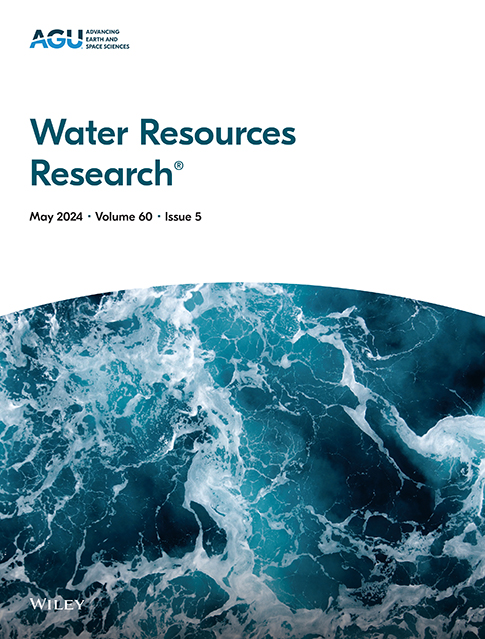利用多个网格降水数据集加强美国连续地区的流量再分析
IF 5
1区 地球科学
Q2 ENVIRONMENTAL SCIENCES
引用次数: 0
摘要
对各种水资源应用至关重要的河流流量观测,往往在需要的关键地点无法获得。虽然已经提出了不同的模型来提高未测量位置的流量可预测性,但挑战超出了模型的保真度。气象强迫数据集的差异,特别是降水,可以显著影响水文预报的准确性。这一挑战在以不同水文气候和地理条件为特征的地区加剧,例如在连续的美国(CONUS),单一降水产品难以始终如一地复制观测到的水文曲线,特别是峰值流量动力学。为了加强流量预测,我们利用VIC-RAPID水文建模框架,该框架由多个常用的气象强迫数据集驱动,如Daymet、PRISM、ST4、AORC及其混合数据集,并创建了多组40年(1980-2019)每小时、每日和每月的流量再分析,Dayflow Version 2,涵盖了横跨美国的270万条河流。除了西部山区的ST4外,大多数强迫导致了良好的水流表现,那里的雷达阻塞严重影响了精度。使用超过6000小时流量测量的评估表明,小时orc和ST4比日流驱动的流量(日流V1)的年峰值流量性能有所改善,特别是在较小的流域,突出了高时间分辨率强迫在水文预测中的价值。与其他基准数据集(如National Water Model V3.0)相比,aorc驱动的VIC-RAPID显示出更好的区域流量性能,具有可比的峰值流量表示。我们设想,多强迫流再分析数据可以为需要强迫数据增强的地区提供信息,诊断水文模型的性能,并使各种水资源应用受益。本文章由计算机程序翻译,如有差异,请以英文原文为准。
Enhancing Streamflow Reanalysis Across the Conterminous US Leveraging Multiple Gridded Precipitation Data Sets
Streamflow observations, essential for various water resource applications, are often unavailable at critical locations in need. Although different models have been proposed to enhance streamflow predictability at ungauged locations, the challenge extends beyond model fidelity. Differences in meteorologic forcing data sets, precipitation in particular, can significantly affect the accuracy of hydrologic predictions. This challenge intensifies across regions characterized by diverse hydro-climatological and geographical conditions, such as in the conterminous US (CONUS) where a single precipitation product struggles to consistently replicate observed hydrographs, particularly peak flow dynamics. To enhance streamflow predictions, we utilize a VIC-RAPID hydrologic modeling framework driven by multiple commonly used meteorological forcing data sets, such as Daymet, PRISM, ST4, AORC, and their hybrids and create multiple sets of 40-year (1980–2019) hourly, daily, and monthly streamflow reanalysis, Dayflow Version 2, for 2.7 million river reaches across the CONUS. Most forcings lead to skillful streamflow performance, except for ST4 in the mountainous west, where severe radar blockage adversely affects the accuracy. The evaluation using over 6,000 hourly stream gauges shows that hourly AORC and ST4 lead to improved annual peak flow performance over Daymet—driven streamflow (Dayflow V1), particularly in smaller basins, highlighting the value of high temporal resolution forcings in hydrologic predictions. Compared with other benchmark data sets like National Water Model V3.0, AORC-driven VIC-RAPID exhibits improved regional streamflow performance, with comparable peak flow representation. We envision that multi-forcing streamflow reanalysis data can inform regions in need of forcing data enhancement, diagnose hydrologic model performance, and benefit diverse water resource applications.
求助全文
通过发布文献求助,成功后即可免费获取论文全文。
去求助
来源期刊

Water Resources Research
环境科学-湖沼学
CiteScore
8.80
自引率
13.00%
发文量
599
审稿时长
3.5 months
期刊介绍:
Water Resources Research (WRR) is an interdisciplinary journal that focuses on hydrology and water resources. It publishes original research in the natural and social sciences of water. It emphasizes the role of water in the Earth system, including physical, chemical, biological, and ecological processes in water resources research and management, including social, policy, and public health implications. It encompasses observational, experimental, theoretical, analytical, numerical, and data-driven approaches that advance the science of water and its management. Submissions are evaluated for their novelty, accuracy, significance, and broader implications of the findings.
 求助内容:
求助内容: 应助结果提醒方式:
应助结果提醒方式:


